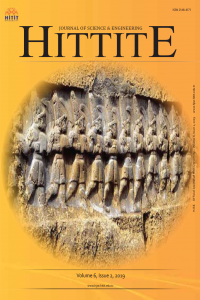Abstract
References
- Shang H, Snape C.E, Kingman S.W, Robinson J.P. Microwave Treatment Of Oil-Contaminated North Sea Drill Cuttings İn A High Power Multimode Cavity. Seperation and Purification Technology 49 (2006) 84-90.
- Robinson J.P, Kingman S.W, Onobrakpeya O. Microwave- Assisted Stripping Of Oil Contaminated Drill Cuttings, Journal of Environmental Management 88 (2008) 211-218.
- Robinson J.P, Kingman S.W, Snape C.E, Barranco R, Shang H, Bradley M.S.A, Bradshaw S.M, Remediation Of Oil- Contaminated Drill Cuttings Using Continuous Microwave Heating, Chemical Engineering Journal 152 (2–3) (2009) 458–463.
- Çelen S, Aktaş T, Karabeyoğlu S. S, Akyıldız A, Zeytin Pirinasının Mikrodalga Enerjisi Kullanılarak Kurutulması Ve Uygun İnce Tabaka Modelinin Belirlenmesi. Tekirdağ Ziraat Fakültesi Dergisi 12 (02) (2015).
- Maskan M, Microwave/Air And Microwave Finish Drying Of Banana. Journal of Food Engineering 44 (2000) 71-78.
Abstract
Drilling sludge DS is one of the most important waste generated during drilling activities and management of drilling sludge DS is highly complicated because of its high moisture content, complex constituents and chemical characteristics. Treatment, transportation and disposal costs of DS are important issues about the management of DS. Restrictive environmental legislation has led to the optimization of solid–liquid separation. Drying process can be defined as an effective solution to reduce sludge mass and thus to reduce management cost. In this study, conventional and microwave drying of DS were compared in terms of process efficiency. Microwave power levels, drying temperature, drying times, moisture content of the DS and energy consumption of drying processes were defined as control parameters. Microwave power levels of 120 and 700 W and 60 and 80 o C were performed to dry the DS sample for microwave and conventional drying, respectively. The results showed that the microwave drying was more effective than conventional method in the view of drying times and energy consumption.
References
- Shang H, Snape C.E, Kingman S.W, Robinson J.P. Microwave Treatment Of Oil-Contaminated North Sea Drill Cuttings İn A High Power Multimode Cavity. Seperation and Purification Technology 49 (2006) 84-90.
- Robinson J.P, Kingman S.W, Onobrakpeya O. Microwave- Assisted Stripping Of Oil Contaminated Drill Cuttings, Journal of Environmental Management 88 (2008) 211-218.
- Robinson J.P, Kingman S.W, Snape C.E, Barranco R, Shang H, Bradley M.S.A, Bradshaw S.M, Remediation Of Oil- Contaminated Drill Cuttings Using Continuous Microwave Heating, Chemical Engineering Journal 152 (2–3) (2009) 458–463.
- Çelen S, Aktaş T, Karabeyoğlu S. S, Akyıldız A, Zeytin Pirinasının Mikrodalga Enerjisi Kullanılarak Kurutulması Ve Uygun İnce Tabaka Modelinin Belirlenmesi. Tekirdağ Ziraat Fakültesi Dergisi 12 (02) (2015).
- Maskan M, Microwave/Air And Microwave Finish Drying Of Banana. Journal of Food Engineering 44 (2000) 71-78.
Details
| Primary Language | English |
|---|---|
| Journal Section | Research Article |
| Authors | |
| Publication Date | June 30, 2019 |
| Published in Issue | Year 2019 Volume: 6 Issue: 2 |
Hittite Journal of Science and Engineering is licensed under a Creative Commons Attribution-NonCommercial 4.0 International License (CC BY NC).


